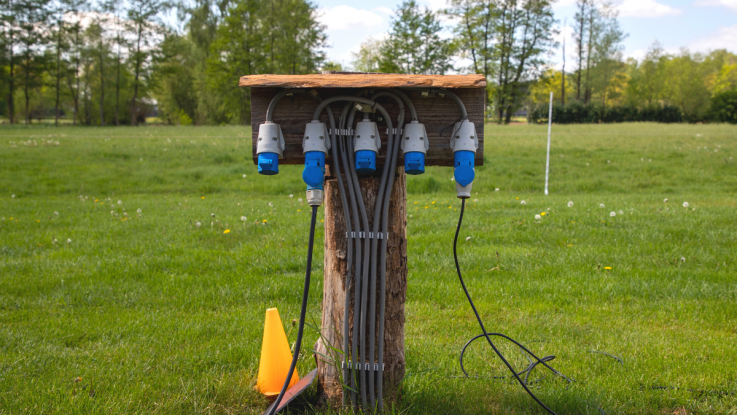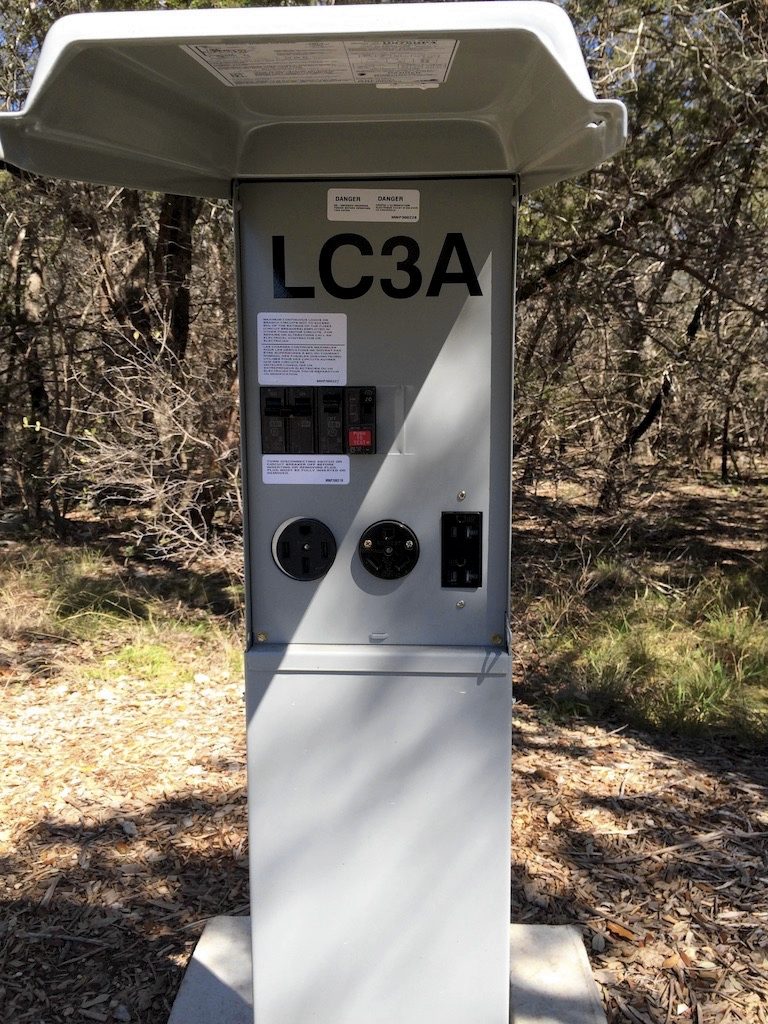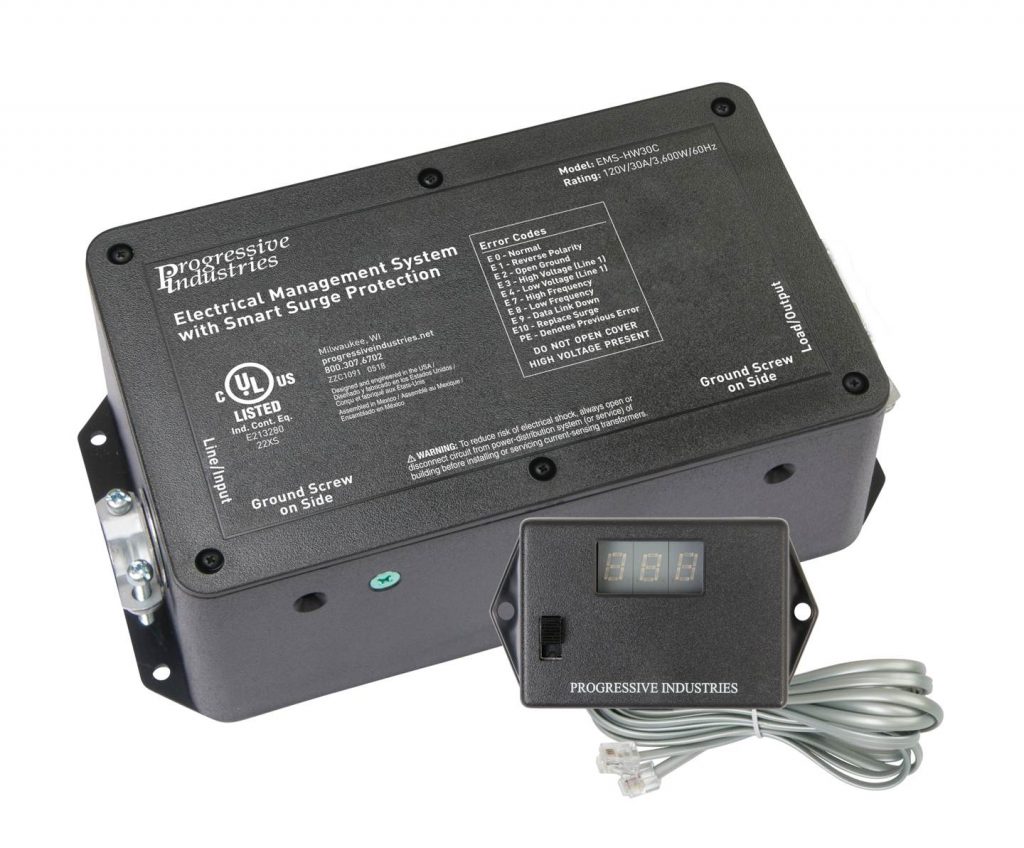

Electricity might not be at the top of your mind when you pull into a campsite at your favorite RV park, but it really should be. Providing your RV with a “clean” source of electrical power is critical. I mean, it’s just electricity… what can go wrong? (Ha ha. Plenty. And it can destroy your RVs electrical system.)
A common misconception is that all campground power outlets are the same. Many people think there is nothing to worry about and you can just plug your power cord in and begin enjoying the new neighborhood. This is just not true. In fact, power pedestals at RV parks can be a beautiful thing or they can be your worst nightmare. Poor quality power, incorrect wiring, and surges can all do major damage to your RV’s electrical system.
Fortunately, there is a way to ensure that the power supply you are using falls into the “beautiful thing” category and doesn’t turn your camping trip into a camping nightmare. All you need to do is use an RV surge protector — or better, an Electrical Management System (EMS).

What Is An RV Surge Protector?
An RV surge protector monitors the power supply before it enters your rig. Functioning properly, it will protect your RV from certain electrical anomalies.
Furthermore, an electrical management system, which is technically also a “surge protector,” does a lot more to protect your RV from power issues. A surge protector protects but to a much smaller degree than an electrical management system.
With a surge protector (always portable, never hard-wired), you plug it directly into the power pedestal. Your RV’s power cord then gets plugged into the surge protector. The unit will detect certain problems before power reaches your rig, thus protecting your RV and camping experience.
What is an Electrical Management System (EMS)?
First, an EMS can be portable or non-portable. Hard-wired EMS’s are permanently installed in your RV. Whether portable or hard-wired, an EMS will monitor the power supply before any electricity reaches your coach’s electrical components.
An RV surge protector only provides protection from voltage spikes such as a lightning strike. It does not protect from too LOW of power coming through (often called a brownout). A brownout can trash your electrical system in your RV just as badly as a surge can.
An electrical management system monitors the condition of the incoming power and will shut off the power supply should certain parameters be exceeded (therefore protecting your RV from potential electrical damage). This includes both voltage spikes and brownouts.
Basic surge protectors and electrical management systems (also called energy management systems) both come in 30-amp and 50-amp versions. Use the version that matches your RV’s power system (usually noted at the RV power cord inlet or in your owner’s manual).
We recommend you use an electrical management system regardless of what type of RV you have, and we will explain why in a bit. But, first, let’s discuss why you need to protect your RV’s electrical system in the first place.
Why Do You Need To Protect Your RV?
In a perfect world, the power outlet you plug your power cord into would provide the perfect voltage and polarity. However, the world of electrical supply is far from perfect.
In order to function correctly and not be damaged, your RV needs to have the correct voltage of power (within a certain range) that is the correct polarity and is grounded properly. Any deviations from a “normal” power supply can result in damage to the appliances and devices that rely on this power supply.
Electrical issues that can damage an RV’s electrical system include:
- High voltage
- Low voltage
- Open ground
- Reverse polarity
What Can Go Wrong with a Power Pedestal
On the surface, a power pedestal is a pretty simple device. It’s literally a pedestal that provides electrical power to your rig. What possibly could go wrong with it? A lot, actually.

- Starting from the outside, the plug itself can be damaged due to use or improperly seated plugs that cause arcing. Always check the physical condition of the female plug on the pedestal before you plug anything into it, or you run the risk of damaging the male plug you are inserting into the pedestal (see images below).
- Internally, the plug itself may not have been wired correctly. It may have just been changed, and the person doing the work didn’t have a clue what they were doing or didn’t tighten things down properly.
- Or, due to age, the internal wiring may have degraded, come loose, or for whatever reason is now in a condition that doesn’t allow it to pass electricity unimpeded.


Then there are issues that can come up throughout the day, when the number of rigs using power in an RV park increases or because of issues with the power supply to the park itself.
For example, on a hot summer day when everyone is using the air conditioner inside their RV, the park’s electrical grid can be greatly strained. This is particularly the case in older RV parks with outdated electrical systems, which may have been put in before the time of monster 50-amp rigs with three air conditioners.
When an RV park’s electrical system is strained beyond capacity, a brownout condition can occur. This results in supplied voltage dropping below a safe level, to the point that it can damage electrical components and appliances.
Before you apply power to your rig, you need to check the power supply at the pedestal to ensure it doesn’t have any issues. You can do this by plugging in a surge protector or electrical management system (the preferred method).
Even the most basic RV surge protector will give a visual warning of an issue (more on this later). And an EMS will only allow power to continue to the RV if no problems are present.
Difference Between Surge Protectors and Electrical Management Systems
Surge Protector: A surge protector only protects your RV from severe voltage spikes. They normally will also give visual indication of problems with the electrical outlet, such as an open ground, reversed polarity, or other wiring issue.

A surge protector will not stop power from being supplied to your rig when one of these conditions exist. They will only alert you (normally via LED indicator lights) and it will be up to you to physically disconnect your RV’s power cord from the power supply.
This is a less than ideal situation as you have to manually intervene when there is an issue. A regular surge protector will also not protect your rig from electrical issues such as over/under voltage that may occur during the day.
Electrical Management System: An electrical management system (EMS) provides the same surge protector functionality, yet offers many more features. In a nutshell, an EMS will not pass power to your RV if there is a wiring issue with the power pedestal, or if there is another electrical supply issue. Only when the power supply is safe for your RV will the EMS let power through.

Also, during the course of the day, if there becomes an over/under voltage situation, the electrical management system will automatically cut power to your RV for a period of time (usually around two minutes). It will then recheck the power supply, and if the problem is no longer present, it will let power flow again.
In other words, an EMS continually monitors the power supply. If a problem is detected, it cuts power to your rig in a matter of milliseconds, preventing any expensive electrical damage from happening.
Conclusion
Power sources for your RV are far from perfect so you need to take the necessary precautions to ensure your RV only receives clean, usable power when it’s plugged in. Investing in a quality device that protects your RV from power issues not only makes sense, it is a must-have before you start any RV adventure.
While an EMS might cost more up front, it only has to work once to earn its keep. A poor electrical supply can cause thousands of dollars in damages to your RV and weeks of downtime. Don’t be afraid to spend a little more up front so that you don’t have major costs down the road!
Marshall Wendler is the co-founder of Camp Addict (FMCA Commercial Member C013759), an RV product education website. Learn more about protecting your RV’s electrical system by reading the Camp Addict RV surge protector guide.


After reading several posts about the quality of campground electrical service, I bought a popular Surge Protect/ Power Monitor. The 2nd time I used it, it detected an “Open Ground” and tripped out.
I contacted the manager who immediately called maintenance, then moved us to another site. The maintenance tech came by to thank me for finding and reporting the problem.
Now then, this is the perfect example of why surge protectors are a necessity. It only takes one bad moment or outlet to cause a disaster for your RV! Glad all turned out ok for ya!